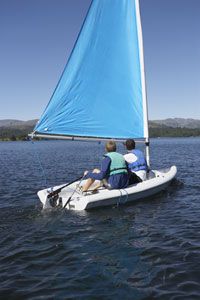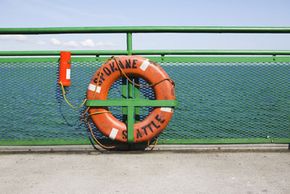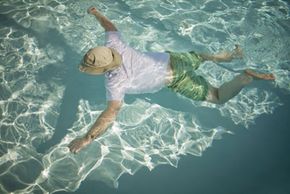
The sun is shining, the water is warm and you and your family are heading out for a three-hour tour on your rented sailboat. You've hoisted the sail, the kids have swabbed the deck and you're bearing away toward a lovely horizon. You have plans to drop anchor, fish a bit and if you're lucky, grill up some fresh seafood for everyone. Then the unthinkable happens. The boom comes loose, and when you move to secure it, you slip and fall into the ocean. You sink for a moment before bobbing back up to the surface, only to see the boat careening away, your family searching in vain for a glimpse of you.
It may sound like a worst case scenario, but a man overboard is actually one of the most common boating emergencies. There are lots of reasons someone suddenly might find himself in the drink. Bad weather is one. Storm fronts can roll in quickly at sea, with strong winds and waves that tilt a boat or ship to-and-fro, making it tough to stay on your feet on deck. Another reason is simple inexperience -- not watching for swinging booms, not realizing how slippery the deck is, moving around the edges without holding on. You could be leaning over the edge, seasick, or maybe you've had too much alcohol and carelessness tilts you into the seawater.
Advertisem*nt
You may think this kind of thing only happens on small sailboats or fishing vessels in rough seas. But on major cruise lines between 1995 and 2007, there were nearly 100 persons overboard [source: cruisejunkie.com]. In some of these cases, people leapt from the ship, either in a suicide attempt or under the throes of alcohol. Other cases were accidental. At least one is believed to be a murder case. The biggest challenge when someone falls from a cruise ship is stopping or turning the ship. It's hard enough to turn a small motorboat or sailboat; it takes much longer for a cruise ship.
Knowing the correct procedures to follow in a man overboard scenario is the only chance you have at pulling a loved one from the water or being rescued yourself. How easy is it to spot a man overboard? Find out on the next page.
Advertisem*nt
Contents
- Man Overboard Rescue Procedures, Steps 1-5
- Man Overboard Treatment
- When You're the Person Overboard
Man Overboard Rescue Procedures, Steps 1-5

When a person suddenly slips overboard, it's frightening, to say the least. The good news is, if someone spots the accident and everyone works together, there's a good chance you can get your companion back into the boat alive and well. The captain should be in charge of leading the rescue effort and assigning jobs as soon as he's aware of the accident.
Step one: The first thing to do if you see someone go overboard is shout "MAN OVERBOARD" as loud as you can along with a port (left) or starboard (right) location. You need to keep your eyes on the victim at all times, so channel your inner drill sergeant and scream. Keep yelling until you get a response that someone else has heard you. As soon as the shout is relayed to the captain, he should shut down the engines or drop sail immediately.
Advertisem*nt
Step two: The spotter should point -- and keep pointing -- at the victim. Spotting and keeping an eye on someone in the middle of the ocean is extremely difficult. Your boat is most likely speeding away in theopposite direction, so if you divert your eyes for even a split second, you could lose him or her. Pointing will give everyone else on board immediate direction. Ideally, the person that spotted the accident should remain the spotter throughout the entire rescue. If you need to reassign the duty, make sure the new spotter has locked eyes on the victim.
Step three: Have someone throw a flotation device into the water for the victim to swim to. Hopefully the person is wearing a personal flotation device (PFD), but many recreational boaters fail to do so. If your boat is traveling at a high rate of speed, start throwing in anything that floats to leave a trail to the scene. Seat cushions, magazines, even your hat -- anything visible that floats can work.
Step four: If you have a smaller or slow-moving boat, you may be able to coast to a stop and throw a lifeline to the victim, and the crisis is averted.
Step five: If the boat has gone too far past the victim, then step four isn't possible. In this case, you'll need to make a turn back to the victim to pick him or her up. Generally, two types of turns are used to quickly return to a point of origin -- the elliptical and the Williamson. The elliptical is an oval (racetrack-shaped) turn and results in an approach to the rear of the victim. After the vessel has some space from the victim, it turns hard on same the side that the incident occurred 180 degrees, straightens out and then performs a second 180 turn to circle around toward the victim. The Williamson turn -- named for United States Navy officer John Williamson -- may be a little quicker. For this one, make a hard turn immediately toward the same side the person went overboard and hold a straight line at 60 degrees from the victim. Then turn hard back the opposite way and circle around until you're on a course heading straight toward the victim from the front. The Williamson takes the shape of a sideways teardrop, with the point of origin being the duct.
Once you've boated back to the victim, how do you pull him or her from the water? Find out on the next page.
Advertisem*nt
Man Overboard Treatment

At this point, your boat has returned to the victim's side. The captain should be careful to approach slowly and cautiously.
Step six: Toss a lifeline with a loop tied into the end to the victim and have him or her hook the loop around their body under the armpits. Tow the person in slowly. If the boat is small, get two people to carefully lift the victim up into the boat by both arms with the victim's back facing them. You can also pull the victim by the life vest if he or she is wearing one. If the victim is strong enough, he or she may be able to climb aboard themselves with the help of a swim ladder.
Advertisem*nt
Unless the accident occurs in the warm waters of the Caribbean, there's a good chance the water is cold. Water has a drastic effect on the body and can cool a person down 25 times faster than cold air [source: boatingbasicsonline.com]. Once aboard, you may find that the victim is suffering from one of the following cold-related illnesses:
Cold shock - Dropping into cold water can cause a quick gasp that lets water into your lungs. If this happens you could drown immediately.
Swimming failure - In cold water, you'll lose dexterity in your limbs quickly and may not able to swim well. When you lose coordination, it's tough to keep your head above water, increasing your risk of drowning.
Hypothermia - Hypothermia happens when your body loses more heat than it produces, and your core body temperature drops below 95 degrees. Some of the symptoms of hypothermia are:
- slurred speech
- stiff joints
- loss of coordination
- slow pulse
- uncontrollable shivering
- loss of bladder control
- puffy face
- mental confusion
To combat hypothermia, get the victim into a warmer environment immediately. Cover him or her with blankets or sleeping bags. Most heat is lost through the head, so cover it immediately. Remove wet clothing and replace it with some dry duds. Always handle hypothermia victims carefully, since they can easily go into cardiac arrest. Keep him horizontal and calm -- reassure him that he's going to be fine. Huddle around and hug the victim to create warmth and then seek professional medical attention as soon as possible.
Here are some more man overboard tips:
- Never jump into the water to rescue a victim unless you're wearing a life vest and are tethered to the boat. Rescue swimming is difficult in the ocean and should only be used as a last resort.
- If the rescue is at night, light a white flare to illuminate the area. The flare will light up the reflective tape on the life vest.
- Never back a boat up to a man overboard -- the propeller can be deadly.
If you haven't succumbed to cold shock, move ahead to the next page to learn what you can do if you're the person overboard.
Advertisem*nt
When You're the Person Overboard

Going overboard is a frightening situation because it happens so quickly. One moment you're enjoying a day at sea. The next, you're plunged into rough and maybe even frigid waters with a chance of dying. There's no easier way to say it than this -- the only job of the man overboard is to stay alive and keep head above water. A rescue attempt isn't a success if the crew pulls a dead body onto the deck. If you're the man overboard, there are a few things you can do to help you in your bid to survive.
If you think you're going overboard, cover your face and mouth with both hands to avoid cold shock. If you aren't wearing a personal flotation device, you'll need to float or tread water. The best way to float is to recline flat on your back with your head above water. Arch your back, extend your arms to the side and let your legs float up in an extended position. This float will help you to conserve energy.
Advertisem*nt
Another method that can save you even more energy is the survival-float, or dead man's float. Here's how to perform this method:
- Take a large breath and then put your face in the water.
- Relax the rest of your body and let it hang -- the back of your head is the only part above the surface.
- When you need a breath, pick up your head and exhale, moving your arms and legs just enough to keep afloat.
- Breathe in deeply and repeat.
If you're a strong swimmer you should be able to tread water. It requires more energy though, so only try this technique if you're certain you'll be rescued very soon and you feel strong enough. Use scissor kicks in a vertical position while waving your arms back and forth with your head above water. If you're wearing a PFD, relax, lie on your back and conserve your energy. If you're in cold water, pull your knees to your chest and hold themto help toretain heat. This is known as the H.E.L.P. -- Heat Escape Lessoning Position.
If you're on a cruise ship and fall overboard, unfortunately your chances of surviving are pretty slim. Stopping a cruise ship takes a while and spotting a man overboard from as high as eight stories above water isn't likely. Rescue boats are deployed as soon as possible, but the likelihood of finding the victim isn't great. The ship is required to make a reasonable search for the victim, but at this time there aren't many regulations in place. Senator John Kerry introduced a cruise ship safety bill in June 2008 that would require among other things:
- peepholes in cabin doors
- increase guard rail heights to 54 inches
- implement man overboard alert systems
For more information on survival and travel, please unwind from the H.E.L.P. position and visit the links below.
Testy Man Overboard
Professor Roger Boshier of the University of British Columbia, Vancouver has done extensive research on man overboard cases, studying the emotional and physical challenges of hundreds of victims who lived to tell their stories. He found that victims often displayed irrational emotions and actions. Oddly, victims thrown overboard in cold water often attempted to take off their clothes, which is a not a good idea. Victims also showed signs of anger regarding the efforts of the rescuers.
Advertisem*nt
Lots More Information
Related HowStuffWorks Articles
- How to Survive a Shipwreck
- How to Build a Shelter
- How to Find Water
- How to Start a Fire Without a Match
- How to Survive a Plane Crash
- How to Survive the Freezing Cold
- Harrowing Survival Stories
- Taken by the Sea: 11 Real-life Shipwrecks
- What causes heat stroke?
- What if my scuba diving equipment failed?
- How do stingrays kill?
- What if I were ice fishing and fell through the ice?
- How Search and Rescue Works
- How Cruise Ships Work
- How Sailing Works
More Great Links
Sources
- "Coping with Man Overboard Situation." sailingandboating.com. 2008. http://www.sailingandboating.co.uk/Coping-with-man-overboard-.html
- "Crew Overboard." boatingbasicsonline.com. 2008. http://www.boatingbasicsonline.com/course/boating/8_3.php
- "Cruise and Ferry Passengers and Crew Overboard 1995 - 2008." cruisejunkie.com. 2008.http://www.cruisejunkie.com/Overboard.html
- "Kerry Introduces Legislation to Protect Passengers on Cruise Ships." senate.gov. June 26, 2008.http://kerry.senate.gov/cfm/record.cfm?id=299847
- "Man Overboard!" freemarine.com. 2008.http://www.free-marine.com/i2overboard.htm
- "Man Overboard: Cutter Jarvis crew conducts survival training in Kodiak." piersystem.com. Jan. 26, 2005. http://www.piersystem.com/go/doc/780/61192/
- "Man-Overboard." sailtexas.com. 2008. http://www.sailtexas.com/ManOverboard.html
- "Water Related Personal Survival." scuba-doc.com. 2008.http://www.scuba-doc.com/overbrd.htm
- Bathhurst, Bella. "Man Overboard." lostmag.com. June 2006. http://www.lostmag.com/issue7/overboard.php
- Boshier, Robert. "Man Overboard: Survivor Stories and Prevention." edst.educ. March 2002.http://www.edst.educ.ubc.ca/rboshier/RBmanoverboard.htm
- Fosha, Rebecca. "How To Survive a Cold Night at Sea." navy.mil. June 2003. http://safetycenter.navy.mil/media/fathom/issues/AprJun03/howtosurvive.htm